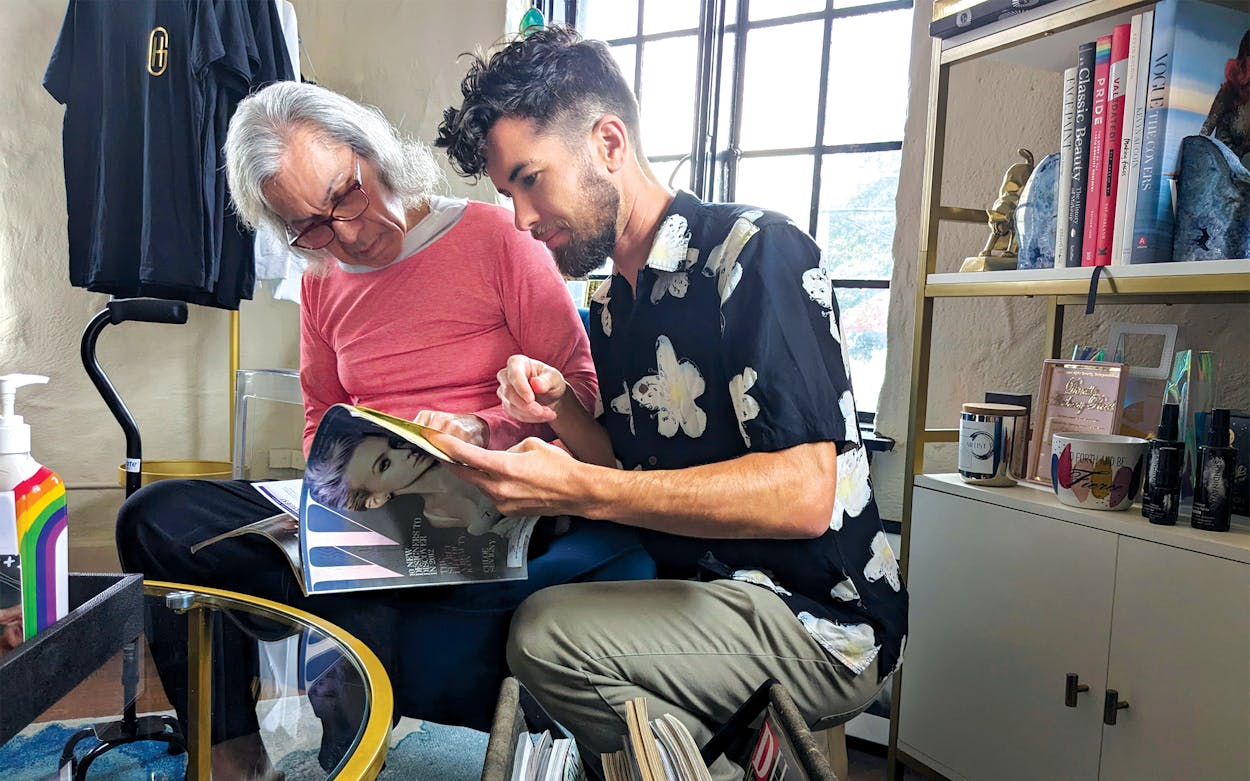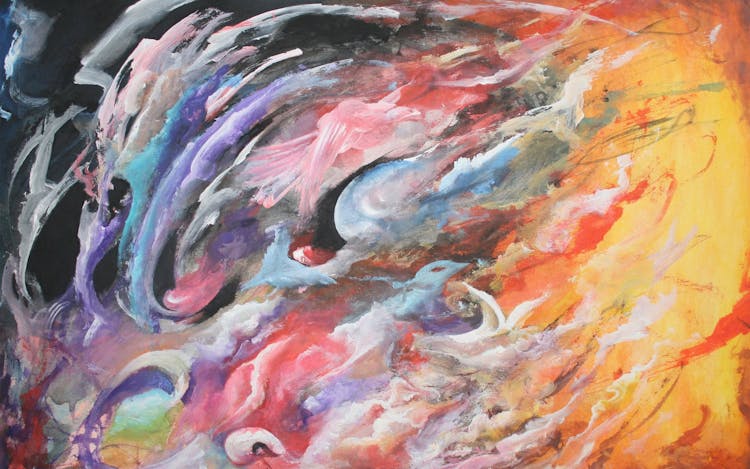A Houston Artist’s Career Took Off While She Was Imprisoned. Now Free, She’s Learning to Paint Again.
Jamie Diaz’s work depicts her experience as a Christian trans woman behind bars in a men’s prison.




Amelia Spinney/Courtesy of Greene Fort Productions, LLC
A day after her release from prison after serving nearly thirty years of a life sentence for aggravated robbery, Jamie Diaz headed to a Dallas salon to have her makeup done. She sat in a chair, her cane within reach, waiting for her appointment. She wore a pink long-sleeved sweater and thin black sweatpants. Her large hands were folded in her lap, left over right, the latter swollen and clenched in a fist since her stroke earlier this year. With gray hair that fell to her shoulders, a furrowed brow, and thin lips that formed a slight smile, Diaz wore an expression both warm and quizzical. She attempted to say something, but her speech was severely impeded.
It was the first time I’d seen Diaz. She barely appears in Love, Jamie, a short documentary about her that’s now streaming on PBS.com’s American Masters Shorts. She shows up only in a few photographs, including one of her smiling from behind a pane of glass at a men’s prison near Houston, where she was incarcerated after her 1996 conviction.
In Love, Jamie’s twenty-minute run time, the documentary, directed by Houston-raised filmmaker Karla Murthy, provides a portrait of a character who is at once a Texan, a Mexican American, a Christian, a trans woman, a prisoner, and a gifted painter who faces with dignity the deprivation of incarceration while creating art that reflects her identity and her experiences behind bars.
Diaz, now 66, grew up in a religious family near downtown Houston in the sixties and seventies. By the time she was a teenager, she’d discovered two truths about herself: she was an artist, and she was queer. She devoured art books and became fascinated with the masters of the Dutch Golden Age, including Rembrandt and Vermeer. She also adored comix—underground comic books that blended humor with obscenity, such as those by the late, great S. Clay Wilson—and studied tattoo artists like Ed Hardy and Cliff Raven.
At fifteen, Diaz began to paint. Around the same time, Diaz, whose sex was assigned male at birth, came out as gay to her mother after getting caught wearing her mom’s makeup and clothes. Throughout adolescence, she also drew comics, played guitar, and, for a brief period in her twenties, worked as a tattoo artist. Houston’s gay scene, including the clubs Heaven and Mary’s, provided Diaz with a sense of social freedom.
But she was a preternatural troublemaker—at one point, she spent six months in juvenile detention—and started experimenting with drugs at an early age. Diaz eventually became addicted to opiates, and she turned to crime to fund her habit. In 1996, she was convicted on charges of aggravated robbery and drug possession. No one was harmed in the incident that got her in trouble with the law, yet the judge slapped Diaz with a life sentence. She harbors no resentment about her punishment. “I’m in prison for robbery and a drug habit, but mostly for being stupid and making bad decisions,” she says in Love, Jamie.
Even behind bars, Diaz, who became open about being a trans woman and began hormone replacement therapy while incarcerated, never stopped drawing and painting. She purchased plastic watercolor sets from the commissary and swapped out the low-quality paints for higher-quality watercolors in the prison craft shop. She made brushes using strands of her hair or those of other inmates whose hair was coarse enough to hold the thicker paints. Some of the whites in her works were created with the same paint that had been slathered onto the prison walls.
In late 2012, she wrote an illustrated letter to Black & Pink, a prison abolitionist organization that advocates for LGBTQ inmates, asking to be put on its pen pal list. Gabriel Joffe, at the time a 23-year-old volunteer for the organization living in Boston, received Diaz’s letter. “The art just really captured me,” Joffe, who is now 34, says in the film. “I don’t think I knew initially what our friendship would become.”


Over the next decade, Joffe and Diaz became close enough to call themselves “chosen family.” Joffe acts as an agent for Diaz, sharing her story and managing a website to showcase her work, which includes comic strips about being a trans inmate in a men’s prison as well as what Diaz calls her “real art.” Her paintings range from the abstract, such as 2013’s Worlds Within Worlds, to the figurative, like 2014’s In the Realm of Mortal Existence. The figurative pieces are impressive, given that Diaz had no models or references to work from behind bars except for the occasional magazine clipping.
Diaz’s work from the past decade is especially striking in the way it mixes Christian and queer imagery, which anticipated an emerging strain of art. Some pieces are overt in their representations. Persecuted, from 2017, depicts Christ in makeup and feminine underwear on a cross adorned with a rainbow flag. Angels, demons, and white doves—the last being a common Christian symbol for the Holy Spirit—regularly appear in her work.
There’s no self-pity in these paintings. Instead, they express unsuppressed joy and liberation in the face of lurking hazards, which Diaz often represents as thorns. Diaz has written about her faith in her comics. “With all of my heart I truly believe that our homosexuality is not a sin. . . . My faith in God is unwavering. God is real. I see his greatness everywhere,” she declares in one. Her themes seem to recall Christ’s words in the Gospel of John: “In the world ye shall have tribulation: but be of good cheer; I have overcome the world.”
Murthy’s film depicts the soul of an artist who retains dignity and love for herself and others in an environment that is designed to break the human spirit. It’s one of the best short documentaries I’ve seen. Viewers will get a mere glimpse of the inferno Diaz and other trans women have been subjected to in men’s prisons in Texas, where inmates are required to serve their time in correctional facilities that align with the gender they were assigned at birth. At one point in the film, we learn, through a letter Diaz wrote from solitary confinement, that she was put there not because of any wrongdoing but because that was where she would be safest from other inmates who were tormenting her.
Love, Jamie also shows Diaz’s recent achievements in the art world. When her work caught the attention of Daniel Cooney, an established New York gallerist, Cooney wrote to her and described her paintings as “beautiful, heartfelt, and strong.” The film culminates with the 2022 exhibition of Diaz’s works at Cooney’s Manhattan gallery, where they won critical acclaim.
Diaz’s voice, as heard in the film, is lively and carries an unmistakable Texas twang. “If I come out [of prison], I will no longer paint any artwork related to prison life,” she says in a phone conversation with Joffe. It’s unclear whether she’ll have the chance to do that. In January, a year before she was due to be granted parole, Diaz suffered a debilitating stroke that severely affected her speech and the right side of her body, including her right hand, which she uses to paint. She was moved to a prison hospital, and her parole date was moved up. On May 31, on the eve of Pride Month and days before the premiere of Love, Jamie on PBS, Diaz was released from prison.
Joffe, who now lives in Denver, was there to receive her. The day was a whirlwind. After an emotional reunion, Joffe drove Diaz to Houston, where they ate brunch in Montrose, the artist’s old stomping grounds, and visited the Rothko Chapel and the Menil Collection. Diaz enjoyed seeing works by Jackson Pollock and René Magritte at the museum, Joffe told me.
The next day the pair drove to Dallas, where Diaz has found temporary housing, and arrived at Glam Haus Collective salon for Diaz’s appointment with a makeup artist. From a young age, Diaz loved getting made up and styling her hair—she was especially fond of curling her locks into an Elvis-like jelly roll—and she continued using beauty products in prison until a guard referred her for disciplinary action over an “extreme hairstyle.” She wrote about the episode in a comic, and the story was retold in Love, Jaime. Another comic strip, from 2019, tells of a longing for “real makeup” rather than the “pastels and grease pencils” she had in her cell. Now free, Diaz could finally get the makeover she’d waited on for years.
While the stylist at Glam Haus Collective worked on Diaz, I chatted with Joffe, who uses gender-neutral pronouns. They told me about plans to help Diaz reintegrate. “We’re still enrolling her in Social Security,” they said. The process of transferring Diaz’s parole to Colorado is also underway. Though she loved growing up in Texas, Diaz wants to restart her life elsewhere and live close to Joffe in Denver. Diaz, Joffe added, is doing physical therapy and has been recovering from the stroke, but it’s not clear if she’ll fully regain use of her right hand. That won’t stop Diaz, who is learning to paint with her left hand so she can continue working toward her goal of creating the world’s largest collection of queer art.
When the makeup artist finished, he held up a mirror so Diaz could see her fresh look. Her lips were painted with a light pink gloss that matched her sweater. Her cheeks had a delicate touch of blush, and she wore an almost imperceptible light blue eye shadow. Diaz gazed in the mirror in silence as she gently touched her face. She looked up and gave an approving smile. As she slowly stood to leave the salon, she burst into tears. Joffe held her as she sobbed, and the stylist rushed over to dab away the tears before her makeup was ruined. Diaz took a moment to collect herself. Then, with a deep breath and the help of her companion, she stepped out onto a Dallas street with her head held high.
- More About:
- Film & TV
- Art
- Documentary
- Houston
- Dallas
This post was originally published on this site be sure to check out more of their content.








